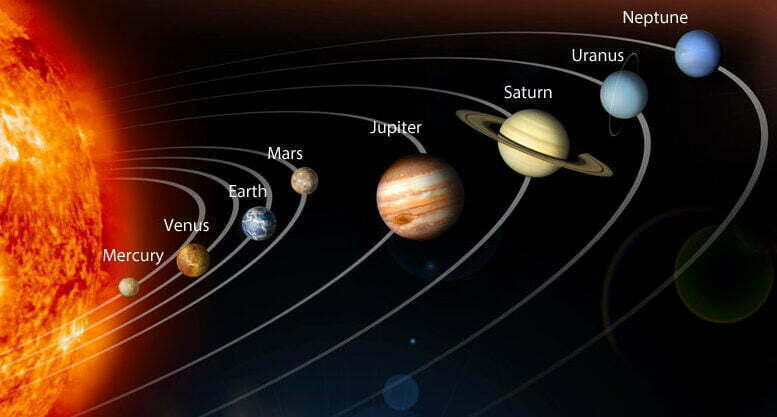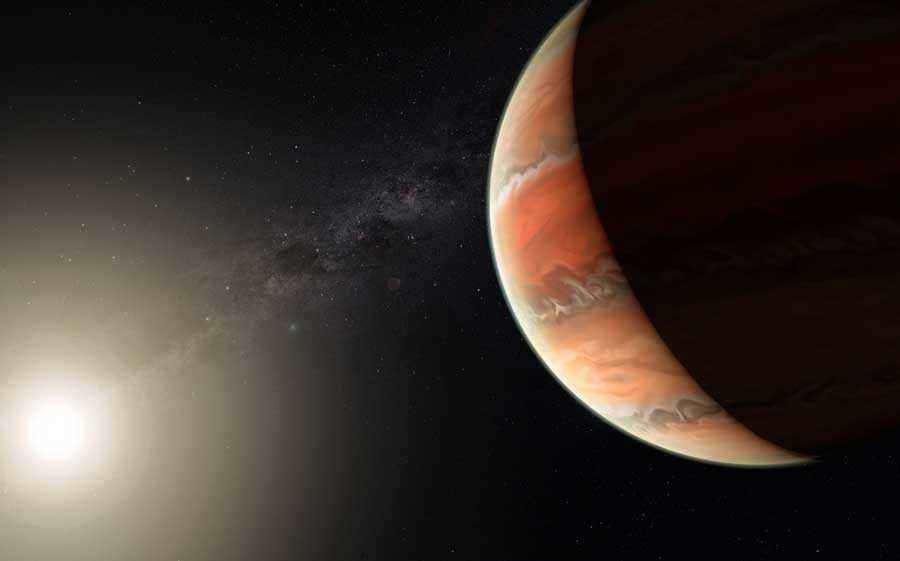
Planets are the largest objects in the Solar System, excluding the Sun. The definition of the term “planet” has been a subject of debate among astronomers for a considerable period of time. However, in 2006, the International Astronomical Union finally formulated a precise definition, which only applies to bodies within our solar system. According to this decision, there are currently eight planets in our system.
The biggest planet in our solar system
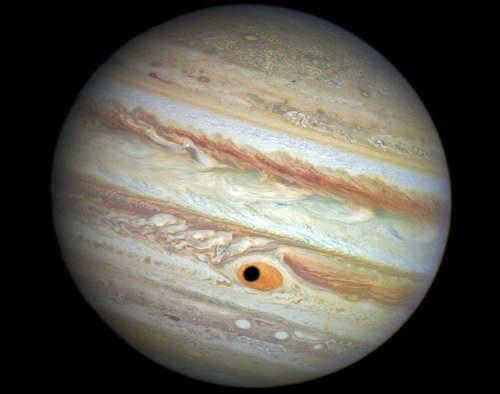
Jupiter, the biggest planet in the solar system, stands out among all other planets. While there are four terrestrial planets that orbit closer to the Sun, Jupiter is a gas giant. Unlike these rocky planets, Jupiter lacks a solid surface. Instead, it features a dense core at its center, surrounded by a vast ocean of liquid hydrogen. Above this ocean lies its atmosphere. Due to the extreme pressure and temperature, there is no clear boundary between the gaseous atmosphere and the liquid ocean. The composition of Jupiter’s atmosphere is primarily hydrogen, accounting for 89%, followed by helium at 10%.
However, Jupiter also contains solid material. At its core lies a rocky mass that exceeds the size of Earth. Enveloping the core is a layer of metallic hydrogen, measuring 45,000 kilometers in thickness. It is worth noting that this information is purely theoretical, as the creation of metallic hydrogen under such immense pressure has yet to be achieved in a laboratory setting.
Jupiter’s shape deviates from the traditional spherical form, appearing flattened at its poles. When measured at the equator, the planet boasts a radius of 71,492 km, while in the polar regions, this measurement decreases to 66,854 km. In comparison, Earth has an average radius of 6,371 kilometers.
Jupiter possesses a mass of 1.9×10^27 kg and a volume of 1.43×10^15 cubic kilometers. Consequently, it is 320 times more massive than our home planet and has a volume 1320 times greater.
Jupiter is the fastest planet in the solar system, completing a revolution around its axis in approximately 10 hours. A year on Jupiter lasts 399 Earth days, and it is interesting to note that Jupiter does not orbit around the Sun, but rather around their shared center of mass, which is located outside of our star. Unlike the other planets in the solar system, the Sun’s center of mass lies within their boundaries.
Jupiter experiences a gravitational force on its hypothetical surface that is 2.5 times stronger than Earth’s.
The planet’s atmosphere is home to extremely powerful winds. The Great Red Spot, a massive hurricane on Jupiter, can even be observed from Earth. This storm is larger than our entire planet, and it used to be twice its current size a century ago. Wind speeds in this area can reach up to 500 km/h.
Observation History of Jupiter
The discovery of Jupiter cannot be attributed to any one person, as knowledge of its existence dates back to ancient times, predating the invention of writing. Jupiter is visible to the naked eye and its distance from Earth varies between 588 and 967 million kilometers. When at its closest, Jupiter shines brighter than any star and is surpassed in brightness only by Venus, the Moon, and the Sun. The ancient Sumerians referred to Jupiter as “Mulu-babbar.” The Greeks, influenced by their mythology, called Jupiter the thunderer Zeus, and the Romans, who heavily borrowed from Greek mythology, adopted this name to honor their supreme deity, Zeus.
Thanks to the telescope, scientists were able to conduct more in-depth research on the planet. Galileo Galilei made a groundbreaking discovery when he identified the four largest moons of Jupiter:
\
Interestingly, there are indications that the Incas had prior knowledge of these moons. It was through the observation of Jupiter’s satellites that Ole Rømer proposed in 1671 that light has a finite speed. This was a significant moment in history as it marked the first time that the speed of light was calculated, with Rømer estimating it to be 215,000 km/s. Remarkably, this calculation was fairly accurate considering that modern data now places the speed of light at 300,000 km/s.
The advancement was linked to the improvement in telescope power and the discovery of new moons, until the Pioneer-10 spacecraft flew by Jupiter in 1973, followed by Pioneer-11 a year later. They not only sent back numerous images of the planet and its moons to Earth, but also gathered data on the magnetic field characteristics. In 1979, the Voyager probes confirmed the presence of rings around Jupiter and also collected data on its atmospheric temperature and chemical composition.
In 1995, the Galileo spacecraft entered Jupiter’s orbit, spending over 8 years there and transmitting a vast amount of information to scientists, forming the foundation of humanity’s understanding of the largest planet in the solar system.
The potential for life on Jupiter
Due to the absence of solid land masses, limited water resources, and an atmosphere primarily composed of hydrogen and helium, the conditions on Jupiter do not support the type of life we are familiar with. However, scientists still speculate that chemical evolution processes could potentially occur in Jupiter’s atmosphere, even though their existence has not been proven. Theoretically, life forms on Jupiter could be based on elements other than carbon, but there is currently no evidence to support this. Instead, scientists believe that it would be more promising to search for signs of life on Jupiter’s numerous satellites.
There have been a total of 67 satellites discovered on Jupiter so far, but it is believed that the actual number is well over one hundred. The Galilean satellites deserve special mention as they are significantly larger than the rest and are comparable in size to the Moon. One interesting fact is that the fifth largest satellite of Jupiter, Amalthea, has a volume that is 6500 times smaller than the smallest Galilean satellite, Europa. It is worth noting that two of the satellites, Themisto and Dia, were initially lost after their discovery due to insufficient data to determine their orbits. However, they were later rediscovered.
Ganymede holds the distinction of being the largest moon in the entire solar system, as well as the largest non-planetary or non-stellar object within it. It even surpasses Mercury in terms of its diameter, measuring an impressive 5268 kilometers, and its volume. Additionally, it is the sole moon to possess its own magnetosphere.
Europa, on the other hand, boasts a surface that is predominantly covered by ice, concealing a vast subterranean ocean of liquid water that reaches depths exceeding 90 kilometers. This intriguing feature raises the possibility of potential life existing on Europa, although current scientific and technological capabilities remain insufficient to definitively prove or disprove this hypothesis.
Jupiter’s Rings
The rings of Jupiter are extremely faint. In 1960, Russian astronomer Sergei Vsekhsviatsky first proposed their existence while studying the orbits of comets. It wasn’t until 1979 that the Voyager satellite confirmed their presence. Jupiter has a total of four rings:
- The halo ring
- The main ring
- The spider ring of Amalthea
- The web ring of Thebes
The Shoemaker-Levy comet’s descent and impact on Jupiter
Back in 1994, astronomers witnessed an unprecedented event in our solar system – the Shoemaker-Levy comet colliding with Jupiter. This cosmic collision consisted of 21 fragments, with each fragment measuring 2 kilometers in diameter. These fragments bombarded the gas giant from July 16 to July 22, with an astonishing impact velocity of 64 kilometers per second. The most massive fragment caused an explosion equivalent to 6,000,000 megatons, surpassing the energy released by the most powerful thermonuclear bomb detonated by humans, a staggering 100,000 times over.
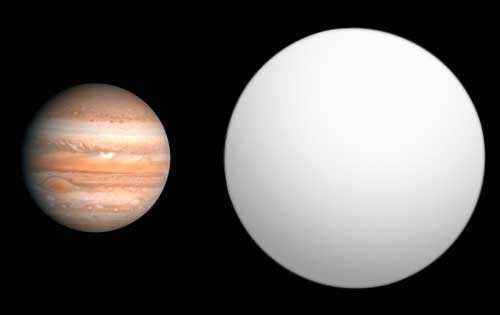
Jupiter, the largest planet in our solar system, has been overshadowed by the discovery of exoplanets in the 1980s and 1990s. These distant celestial bodies, found in other star systems, pose a challenge for astronomers due to their distance from Earth, lack of light emission, and relatively small size. The study of exoplanets is further complicated by the fact that excessively massive planets cannot exist, as their own gravity would compress them to the point of triggering thermonuclear reactions, transforming them into stars or brown dwarfs. As a result, scientists often struggle to determine whether they have stumbled upon an exoplanet or a brown dwarf. This confusion is largely due to the absence of a precise definition for exoplanets.
It is a challenging task to accurately determine the dimensions of exoplanets, resulting in multiple contenders for the largest known planet in the universe. However, leading the pack is WASP-17 b. With a radius between 1.91 and 2.07 times that of Jupiter, this planet measures at least 136,000 km in size. Its discovery took place on August 11, 2009, utilizing a telescope located in South Africa. WASP-17 b resides 1000 light years away from us in the Scorpius constellation. It stands out from other exoplanets due to its unique set of characteristics.
Weighing in at half the mass of Jupiter, the planet boasts an expansive size and low density. In fact, its matter is 10 times less dense than water. This low density prevents the planet from transforming into a brown dwarf or a star under the influence of gravity.
WASP-17 b possesses an additional characteristic in that its orbit runs counter to the rotation of its star. This is an unprecedented discovery, as subsequent research has found several more exoplanets with a retrograde orbit. The existence of these planets contradicts the established theory of planet formation, necessitating a revision of the current understanding.
In addition, WASP-17 b maintains an incredibly close proximity to its star, with a distance seven times smaller than that between the Sun and Mercury. A single year on this planet lasts less than four Earth days, and surface temperatures can reach up to 1500 K.
It should be pointed out that there have been several other planets found in the Universe that possess a significant size (up to 2 times the radius of Jupiter), low density, and are in close proximity to their respective stars. These planets are commonly classified as “hot Jupiters” and “loose planets”. It is highly likely that future discoveries of giant planets will also fall into this category of celestial objects.
While Mercury holds the title for being the closest planet to the Sun, it does not claim the record for being the hottest object in our Solar System. Among the planets, Venus is considered the hottest, but when it comes to exoplanets, it faces competition from KELT-9b.
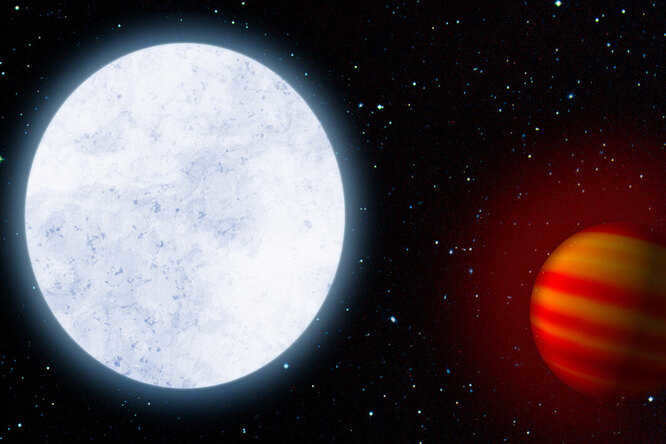
What is the hottest exoplanet in the universe?
Every 36 hours, a massive planet similar in size to Jupiter completes a full orbit around its host star, which is one of the largest stars known to have planets. This is the reason why Kelt-9b, the planet in question, reaches an astonishing temperature of 4,327 degrees Celsius.
To stay informed and connected, make sure to follow us on Yandex.Zen and subscribe to our channels on Telegram, VKontakte, and Odnoklassniki!
What is the appearance of the hottest planet?
The extreme heat on the hottest planet causes the molecules on its sun-facing side to break apart, while heavy metals accumulate on the opposite side. To the human eye, the day side of this planet would appear slightly dimmer and more orange than the Sun, while the night side would resemble a red dwarf. A recent discovery of this phenomenon was reported in the prestigious journal Nature. Most of the planets that scientists have identified orbit small stars known as red dwarfs, as these planets are easier to detect. The dimness of the stars and the noticeable movement of objects against their backdrop make them ideal for planet hunting. However, larger and brighter stars present a different challenge, as they can easily conceal planets within their own systems. Consequently, our knowledge about these celestial bodies remains limited.
What planet held the title of hottest planet prior to the discovery of KELT-9b?
WASP-33b was the reigning champion of hottest exoplanet before the discovery of KELT-9b. With a scorching surface temperature of approximately 3,500 kelvin, WASP-33b was a formidable contender. However, within our own solar system, Venus claims the title of hottest planet. Venus’ surface temperature can reach anywhere from 460 to 480 degrees, making it an inferno. Additionally, Venus boasts incredibly high levels of carbon dioxide, resulting in atmospheric pressure readings that are 92 times greater than those on Earth. This fiery planet also absorbs copious amounts of solar radiation, further adding to its blistering heat.
Venus is commonly known as Earth’s twin sister due to its comparable size, density, mass, and composition. However, the two planets differ greatly in all other aspects. Despite extensive research, it wasn’t until the 20th century that scientists were able to determine Venus’ temperature, which earned it the title of the hottest planet. The Soviet Union played a significant role in this discovery, as it was Soviet spacecraft that first transmitted successful images of Venus’ surface and data on its chemical makeup.
Why isn’t Mercury the hottest planet?
Even though it is closer to the Sun, Mercury is actually colder than Venus. The average surface temperature of Mercury is about 50 degrees lower than that of Venus, reaching a value of 426º Celsius. The main reason for this difference is the atmosphere. Mercury has a very thin atmosphere, while Venus has a dense atmosphere composed of carbon dioxide and sulfuric acid clouds. This dense atmosphere traps heat inside the planet, making Venus the hottest planet in the entire solar system.
- First place goes to Venus, with a scorching temperature of 464º C
- Coming in second is Mercury, with a temperature of 167º C
- In third place is our very own Earth, with a comfortable temperature of 15º C
- Mars takes the fourth spot, with a chilly temperature of -65º C
- Finishing off the list is Jupiter, with an icy temperature of -110º C
TechInsider network edition
Founder of “Fashion Press” LLC: 119435, Moscow, Bolshoi Savvinsky per. 12, str. 6, floor 3, room II;
Address of the editorial office: 119435, Moscow, Bolshoi Savvinsky per. 12, p. 6, str. 6, floor 3, room II; Editorial office address: 119435, Moscow, Bolshoi Savvinsky per. 6, floor 3, room II;
Chief Editor: Nikita Vasilenok
Email address of the editorial office: [email protected]
Phone number of the editorial office: +7 (495) 252-09-99
Label for information product: 16+
The network edition is registered with the Federal Service for Supervision in the Sphere of Communications, Information Technologies and Mass Media, registration number and date of registration decision: series EL No. FS 77 – 84123 dated November 09, 2022.
© 2007 – 2023 "Fashion Press" Ltd.
By submitting content to the Website, the User gives "Fashion Press" LLC the right to use, reproduce, distribute, modify, and publicly display the content without any compensation.
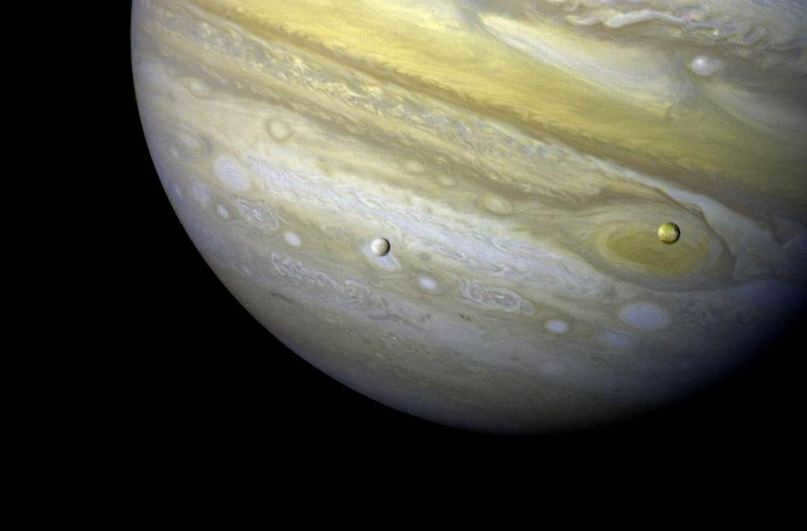
Out of all the planets that are currently known, there is only one that can rival the Sun in its magnificence, and that planet is none other than Jupiter, the largest planet in our solar system. Named after the Roman god of the state, Jupiter is a gas giant that boasts a mass of 317.8 times that of the Earth. This makes it several times heavier than any other planet in our solar system, and even if you were to combine the masses of all the other planets, Jupiter would still outweigh them all. Despite its immense size, Jupiter’s density is only 1.33 g/cm, which is four times less than the density of the Earth.
Rotation animation created using Vauger’s images.
This celestial body, measuring 69,911 km in radius, is situated far from the primary asteroid belt and is the fifth planet from the Sun.
The massive planet’s rotation, captured by the New Horizons probe.
It takes nearly 12 years to complete a full orbit, with an average velocity of 13.1 km/s, while the time it takes for this planet to complete one rotation on its axis, spinning at a speed of 45,000 km/hour, is approximately 10 hours.
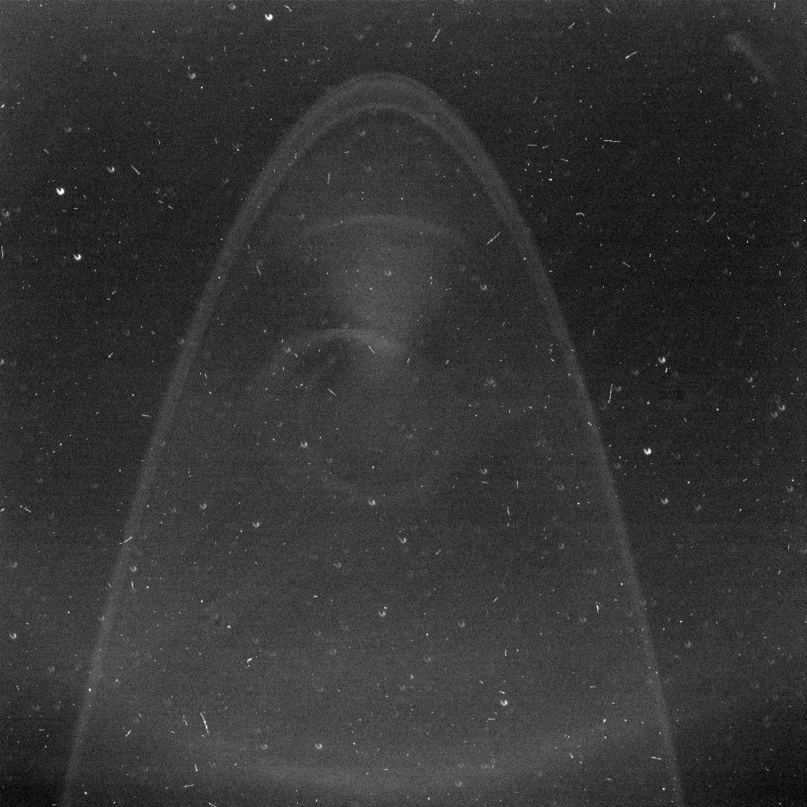

The New Horizons probe captured stunning images of Jupiter’s rings during its mission. These rings, first discovered by Galileo in 1610, are known to be exceptionally large in size. They orbit the planet in nearly perfect circles along the equator. Additionally, there are 20 outer satellites that are so distant from Jupiter that they cannot be seen with the naked eye from the planet’s surface. To observers on Jupiter, these outer satellites appear smaller than the Moon.
Jupiter is perpetually in a state of summertime!
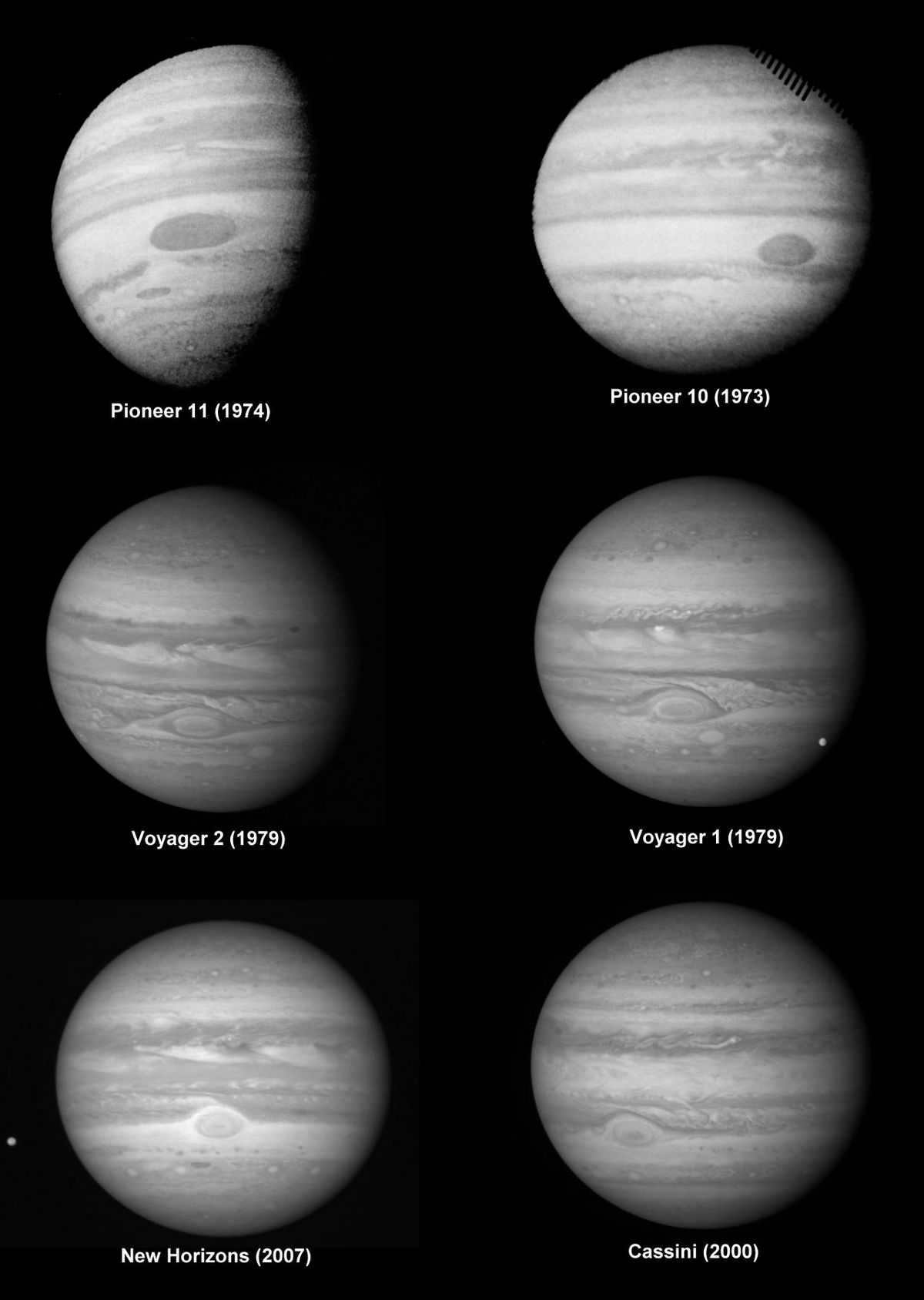
Images captured by six spacecraft showcase the majestic beauty of Jupiter.
Unlike terrestrial planets, Jupiter is composed primarily of liquid and gas, resulting in a unique rotation pattern. The planet’s equator spins slightly faster and its axis of rotation is nearly perpendicular to its orbit. The immense centrifugal forces exerted on Jupiter have caused it to take on a flattened, spherical shape. As a result of these factors, Jupiter does not experience the changing of seasons that is characteristic of other planets.
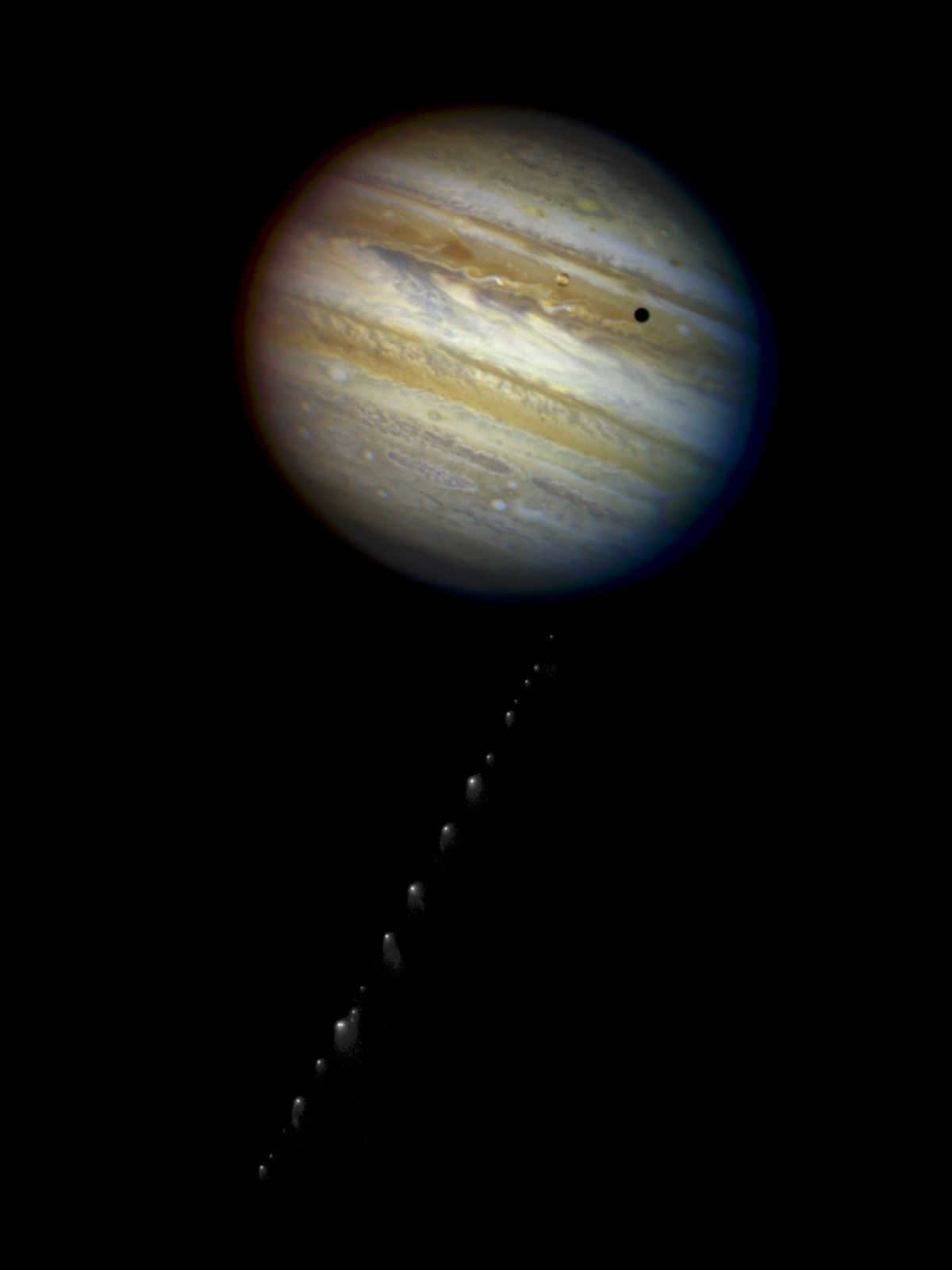
Composite image of Jupiter and comet Shoemaker-Levy 9
Jupiter emits a significant amount of thermal energy into its surroundings due to the constant radioactive decays occurring on its surface. This heat production surpasses the energy it receives from the Sun, making Jupiter serve as a kind of secondary Sun.
Ganymede’s transit across Jupiter’s surface
The gas giant’s atmosphere displays a distinct orange hue, which is attributed to the presence of compounds such as phosphorus and sulfur. Composed of 11% helium and 89% hydrogen, Jupiter’s atmosphere shares a striking resemblance to the chemical makeup of the Sun. However, this environment is unsuitable for supporting any form of life.
The ambiance of a gas giant
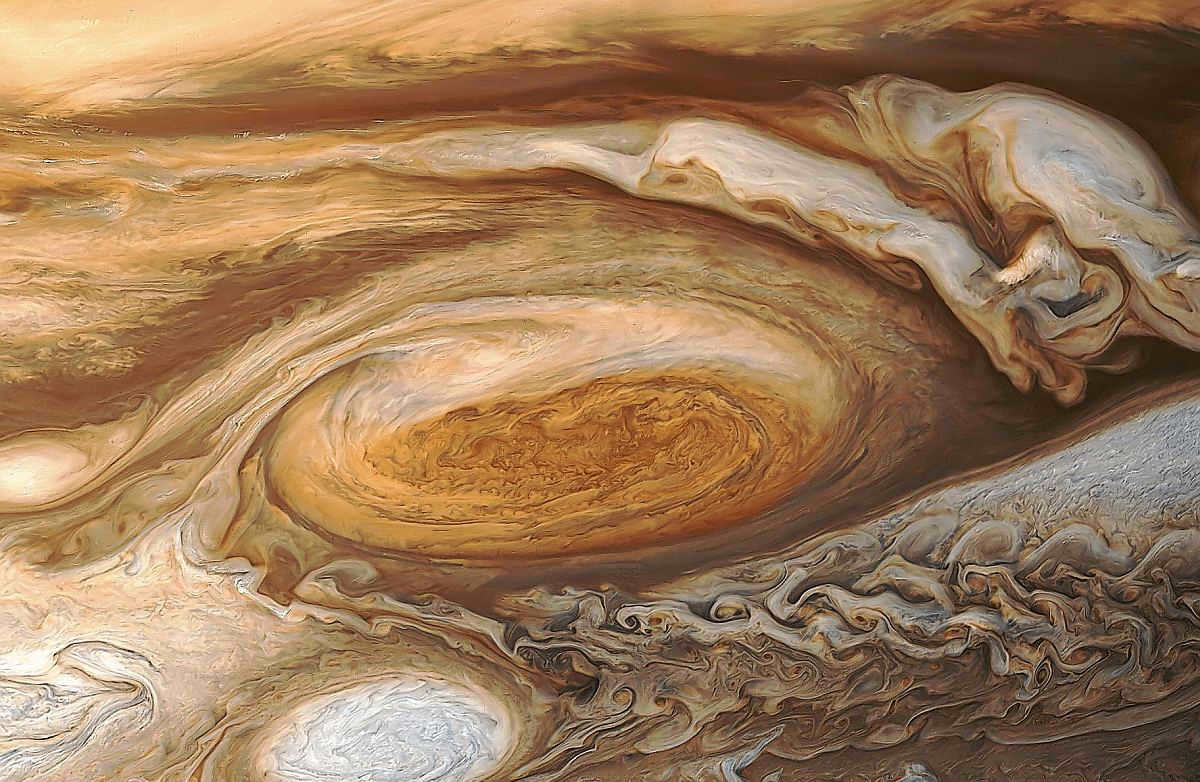
According to scientists, the gas giant is believed to have an atmosphere composed of three primary layers. The outermost layer is thought to be comprised of frozen ammonia, followed by a layer of ammonium sulfide and methane, while the innermost layer, closest to the planet’s surface, is believed to be made up of ice or water.
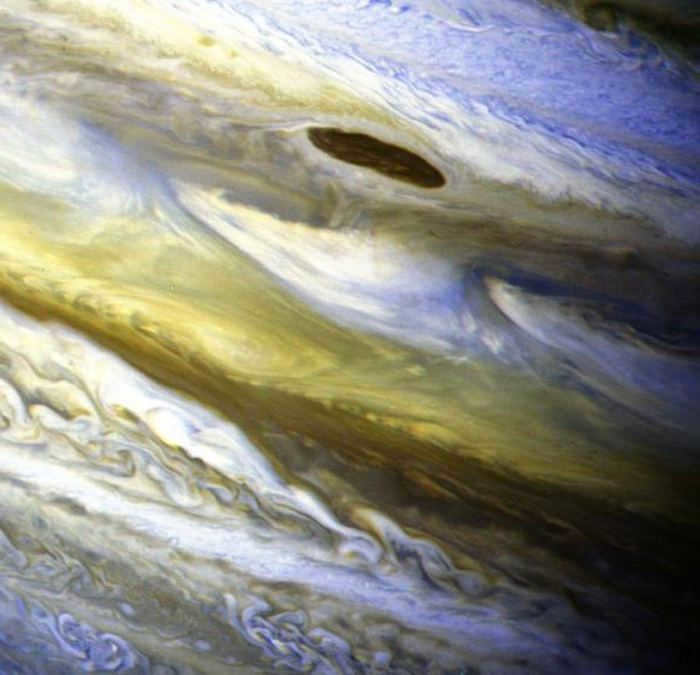
The colors of Jupiter’s equatorial zone are enhanced.
The atmosphere of this giant planet, like that of other gas-rich planets, is characterized by incredibly fast winds. These winds blow parallel to the equator and can reach speeds of up to 500 kilometers per hour. The wind streams on Jupiter exist both on its surface and within its interior, indicating that they are driven by the planet’s internal energy rather than by the Sun’s energy, as is the case on Earth.
A fascinating documentary about Jupiter

Not all individuals across the globe possess the knowledge regarding the identity of the largest celestial body within our solar system. Naturally, if your child has an interest in the field of astronomy, then you are likely aware of the answer to this inquiry. However, for those who are not well-versed in the order of the planets within our system or the number of satellites orbiting Mars, do you possess this information? Excellent! Nevertheless, for those who remain unaware of the identity of the largest planet in our solar system, we present this informative article.
What is the largest planet in our solar system?

Jupiter currently has 67 moons, with the four largest being known as the Galilean moons, named after their discoverer Galileo Galilei. These four moons are Io, Europa, Ganymede, and Callisto.
Fascinating information about the largest planet in our solar system
1. Similar to Earth, polar auroras occur on Jupiter at its poles. However, the aurora activity on Jupiter is significantly more intense and rarely ceases. The powerful radiation, combined with Jupiter’s magnetic field, interacts with the planet’s ionosphere, resulting in a truly breathtaking light display.
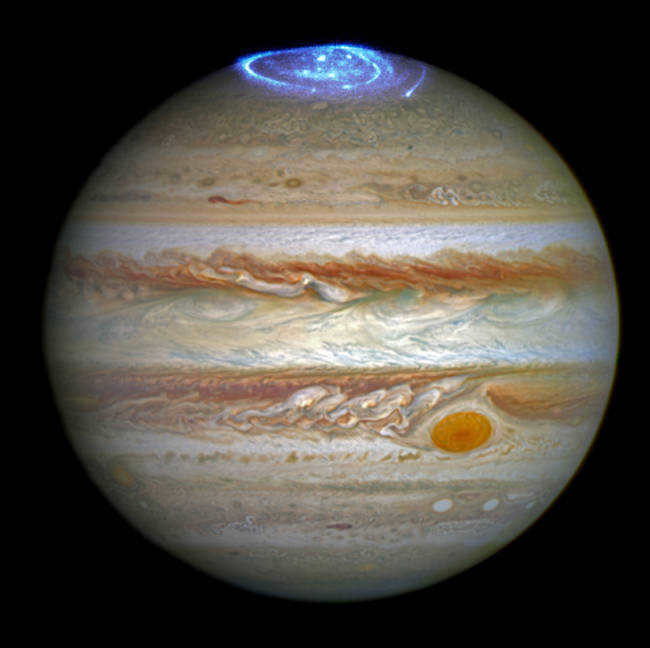
2- Jupiter, the largest planet in our solar system, boasts a dense and intriguing atmosphere comprised mostly of hydrogen and helium gases. Within this atmospheric layer, powerful winds whip around at incredible speeds, reaching up to an astonishing 620 km/h. It is within this tumultuous environment that massive hurricanes are born, rapidly growing in size and scope within a matter of hours. These colossal storms can expand to span thousands of kilometers in diameter in a single night, truly demonstrating the awe-inspiring power of Jupiter’s atmosphere. What is perhaps even more astonishing is the incredible longevity of these storms; some have been known to persist for centuries or even longer. One such storm, the Great Red Spot, is particularly renowned. Raging for a minimum of 300 years, this iconic storm has ebbed and flowed in size over the centuries. In fact, there was even speculation in 2012 that this giant red spot might eventually vanish altogether. Nonetheless, as of now, the Red Spot remains, measuring an impressive 15900 kilometers in size.
3- The discovery of new exoplanets demonstrates that there are planets that can surpass Jupiter in size. In fact, the Kepler space probe (as well as ground-based telescopes) has observed an astonishing number of “super-Jupiters” in recent years. Since 2015, more than 300 such planets have been identified.
4. Similar to Saturn, Jupiter possesses a ring system that includes an inner layer of small particles called a halo, a main ring that is brighter than the others, and an outer “spider” ring. This ring system is relatively faint and is composed mostly of dust, believed to have formed through collisions between the largest planet’s satellites.
5. The ancient Romans named this planet Jupiter after their king of the gods. As we continue to discover more about this Solar System giant, it becomes increasingly evident that it truly deserves this name.
6. Despite its massive dimensions and atmospheric composition, Jupiter will never undergo stellar fusion and become a star.
The mesmerizing aurora borealis on Jupiter, the largest celestial body in our solar system
This awe-inspiring footage showcases one of the most breathtaking atmospheric occurrences on Jupiter, as observed and recorded by the Hubble Space Telescope.
Those who have experience with traveling are aware that even if you dedicate your entire life to this pursuit, there will always be a small, or even a large, portion of the Earth that remains unexplored. It appears as though our planet is filled with vast expanses that are limitless. Trying to close our eyes and imagine the entirety of it seems like an impossible task. However, the Earth falls into the category of objects in space that can be classified as “small planets of the solar system”. These planets, scientifically known as Earth group planets, are quite modest when compared to the universal scale. Our Earth would seem even more infinite if it approached the size of gas giants, which we will discuss further below.

First of all, let’s discuss the fundamental concept behind the categorization of planets in astronomy. The planetary system is divided into two sections by the Main Asteroid Belt. The initial section comprises Mercury, Venus, Earth, and Mars. Jupiter, Saturn, Uranus, and Neptune form the second section, followed by Pluto and the Kuiper Belt. The first four planets belong to the Earth group. Aside from their position, they share common characteristics such as being composed of metal and silicon compounds, and having a core, mantle, and crust. Among this group, Earth stands out as the largest planet in the solar system.
The gas giants, which are located beyond the Asteroid Belt, are known for their immense size, surpassing that of the planets in the Earth group. However, what sets them apart the most is the composition of the matter that comprises these celestial bodies. Unlike Earth and other similar planets, the gas giants are primarily made up of a combination of gases including hydrogen, helium, ammonia, and methane.
Ninth
In 2006, Pluto was “demoted” to a dwarf planet and classified as an object in the Kuiper belt, a structure that is sufficiently distant from Earth but still within the solar system. According to scientists, Pluto does not meet one of the criteria for being classified as a planet, as it does not have enough mass to clear its orbit of other bodies. However, its composition is similar to that of other bodies in the Kuiper belt, consisting of frozen methane and nitrogen.
Currently, there are only eight planets in our solar system, along with a few more dwarf planets that will never be considered full-fledged planets.
Which planet is the biggest in our solar system?

Undoubtedly, the gas giants are the primary contenders when it comes to finding the most colossal celestial body. However, the answer to the query “which planet in the solar system is the largest” is common knowledge even among young students. It is none other than Jupiter – the majestic giant positioned just beyond the Main Asteroid Belt. It is believed that Jupiter may have played a crucial role in the development of life on Earth by shielding it from potential meteorite impacts throughout its existence.
Once again, it is incredibly challenging to comprehend the enormity of Jupiter if you attempt to visualize an object 1300 times the size of Earth. Comparisons come to the rescue: Jupiter is a planet in the solar system that is approximately the size of a soccer ball. The storm unraveling in the atmosphere of this giant is so massive that it could engulf all the planets in the Earth group, except Mercury, combined.
Not only is the size impressive, but the speed of Jupiter’s rotation is also mind-boggling. It completes one revolution around its axis in just 10 hours, moving at a velocity of 45,300 km/h. Simultaneously, this colossal planet orbits the Sun in 12 years. That is quite swift as well, considering its distance from the Sun, which is five times farther away than Earth.
Ephemeral surface
After discovering that Jupiter’s surface is inaccessible, many students who had previously been fascinated by the idea of walking or traveling on the largest planet in the solar system were left disappointed. The realization that no human could ever set foot on Jupiter’s surface was disheartening. This is because Jupiter is enveloped by a thick atmosphere composed mostly of hydrogen and helium, with a ratio of 9:1. The atmosphere gradually transitions into liquid hydrogen, making it impossible to distinguish a clear boundary between the atmosphere and the planet’s surface. Instead, the boundary is conventionally defined by the pressure level.
Clouds and Spots
When observing the photographs of Jupiter closely, it becomes evident that the planet possesses a distinct and recognizable appearance. The upper atmosphere displays a striped pattern consisting of stable clouds, with light-colored zones alternating with reddish-brown belts. These clouds are formed by powerful atmospheric flows, also known as jets in scientific terminology, that are located in between. These jets are actually winds of immense strength, with their direction either aligning with or opposing the planet’s motion. The clouds, both light and dark, along with the jets, are commonly referred to as geographic features on the conventional surface of this gaseous giant.
The primary characteristic
Jupiter’s surface is distinguished by a unique phenomenon known as the Great Red Spot, making it a standout feature of the planet. This exceptional formation, with its intense and enduring color, is not observed on any other celestial bodies within the solar system. Researchers propose that the Great Red Spot is an enormous storm within Jupiter’s atmosphere. It traverses the planet, shifting in longitude, while remaining consistently fixed at the same latitude for a minimum of 350 years. Moreover, the spot exhibits fluctuations in size, expanding to a massive scale before contracting by fifty percent.

Research on spacecraft has confirmed astronomers’ hypothesis that the Great Red Spot on Jupiter is a massive anticyclone that rotates counterclockwise, completing one revolution every six days.
The Nearest Neighbor of the Giant
Jupiter is home to many intriguing phenomena, but one that stands out is its “companion” planet, Saturn. It is nearly impossible to mistake Saturn for any other celestial body in the solar system. Its most distinctive feature is its prominent rings. Interestingly, all gas giants in our solar system possess such formations, as well as moons. However, Saturn’s rings are particularly renowned for their breathtaking beauty. Composed of ice particles with a small mixture of heavy elements and dust, they captivate the imagination.

The composition of Saturn is comparable to that of Jupiter, consisting of hydrogen, helium, methane, ammonia, and various impurities. However, unlike Jupiter, the planet’s surface, which can be observed from space, is less stable. Additionally, the winds on Saturn are considerably stronger.
The frosty titans

Uranus and Neptune come after Saturn in the solar system. Astronomers classify them as ice giants because they lack the metallic hydrogen found in Jupiter and Saturn, but instead have a significant amount of ice in high-temperature forms. One of the most distinctive features of Uranus is its tilted axis. The planet appears to be lying on its side, resulting in the Sun predominantly illuminating the North and South Poles rather than the equatorial zone.
Neptune boasts the strongest winds among all the planets. Its surface showcases a feature similar to Jupiter’s Great Red Spot, known as the Great Dark Spot.


